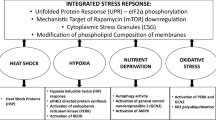Abstract.
Since its discovery in 1962 by Ritossa, the heat shock response has been extensively studied by a number of investigators to understand the molecular mechanism underlying the cellular response to heat stress. The most well characterized heat shock response is induction of the heat shock proteins that function as molecular chaperones and exert cell cycle regulatory and anti-apoptotic activities. While most investigators have focused their studies on the toxic effects of heat stress in organisms such as severe heat stress-induced cell cycle arrest and apoptosis, the cellular response to fever-ranged mild heat stress has been rather underestimated. However, the cellular response to mild heat stress is likely to be more important in a physiological sense than that to severe heat stress because the body temperature of homeothermic animals increases by only 1–2°C during febrile diseases. Here we provide information that mild heat stress does have some beneficial role in organisms via positively regulating cell proliferation and differentiation, and immune response in mammalian cells.
Similar content being viewed by others
Author information
Authors and Affiliations
Corresponding author
Additional information
Received 14 May 2004; received after revision 2 August 2004; accepted 16 August 2004
Rights and permissions
About this article
Cite this article
Park, H.G., Han, S.I., Oh, S.Y. et al. Cellular responses to mild heat stress. CMLS, Cell. Mol. Life Sci. 62, 10–23 (2005). https://doi.org/10.1007/s00018-004-4208-7
Issue Date:
DOI: https://doi.org/10.1007/s00018-004-4208-7



